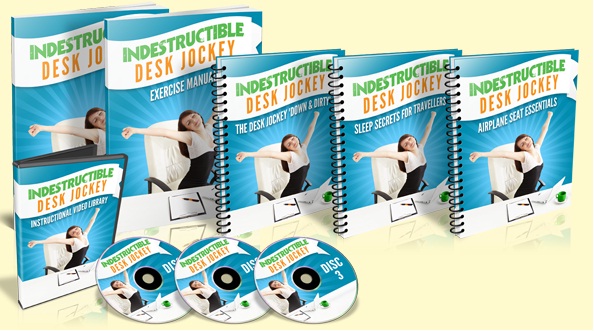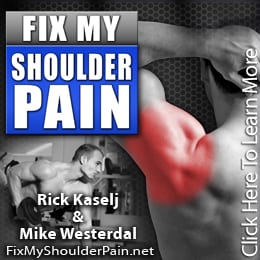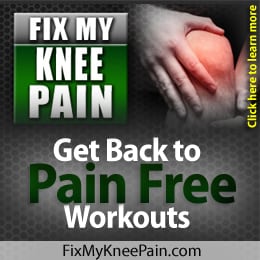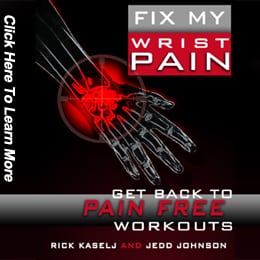Keeping the Desk Jockey Injury Free
Have an interview with the author of the Indestructible Desk Jockey on what you can do to keep those that sit all day, injury free.
Enjoy.
~ Rick
===============================
Rick – Kathryn, could you introduce yourself to the readers?
Kathryn – Rick, thanks for inviting me for this interview.
I loved sports and hiking as a kid. Unfortunately, injury and illness from undiagnosed celiac disease frequently pulled me out of the game. When a doctor told me at age 19 that a wheelchair was likely to be in my future, I began a journey that changed my life.
I poured myself into learning everything I could about the body and nutrition. My studies ultimately led to earning a Doctorate of Chiropractic, and in 1994 I opened my office.
The limitations I experienced in my own life spurred me to find effective ways of helping my clients heal, live pain-free, and reclaim their lives. My doctors didn’t even consider celiac disease because I was overweight.
We now know that 60% of people with celiac disease are obese instead of underweight. Although it’s sad that I went through needless pain for 37 years before diagnosis, understanding how limiting pain can be inspired me to help as many people as possible live a pain-free life.
I closed my clinic in 2009 to publish a novel and a fitness book. I hope to reach even more people through my writing and to inspire others to leave behind lifestyles of surviving as they reach within themselves and learn to thrive.
Indestructible Desk Jockey is my most recent release. Created for those of us who sit the majority of our work day, Desk Jockey comes loaded with self-evaluations and the tools you need to get rid of those aches and pains brought on by long hours at a desk.
Rick – What is celiac disease?
Kathryn – When people with celiac disease eat gluten, an auto-immune process kicks in damaging their small intestine and limiting the nutrients they can absorb. (Gluten is a protein found in wheat, barley, and rye or anything contaminated by one of those grains.)
Because those with celiac can’t absorb vitamins and minerals well, they can’t always keep up with the repair demands that go with day to day life and that leads to things like anemia, less dense bones, excessive hunger, nerve damage, headaches, joint pain, chronic inflammation, other auto-immune diseases, and a host of other problems.
Some people with celiac disease have lots of stomach pain, and those folks usually have no appetite and are extremely thin while others have no noticeable stomach issues but are constantly hungry and typically overweight.
Rick – For a trainer or coach that has a client with celiac disease do you have any exercise recommendations or guidelines?
Kathryn – For someone who has avoided gluten for at least a year, restored their vitamin and mineral stores through nutrient-dense food choices and possibly supplementation, and no longer has any symptoms, he or she really isn’t any different than anyone else.
However… If the diagnosis is new or if their client has been accidentally “glutened” recently, trainers and coaches need to factor in increased recovery time for about six months. Even if they don’t have symptoms, the autoimmune process lasts at least six months and can last over a year for those newly diagnosed. They’ll need more non-training days than the average client.
If anemia is present, avoid distance running or lots of foot impact until the anemia has been corrected. The impact can destroy even more red blood cells and slow the client’s recovery.
Remember, gluten damages the small intestine and limits nutrient absorption for clients with celiac disease. So don’t assume that supplying supplements will heal them faster. While nutrient-dense food is needed in order to heal, the damage to their small intestine will limit what they can absorb. If they can’t absorb very much, adding more isn’t going to make a difference because they simply can’t absorb it.
If it isn’t already part of the training program, make sure to add some joint mobility to help celiac clients get nutrients in and pump waste out of their joints.
Rick – As a chiropractor, what were the top 3 most common injuries you came across?
Kathryn – Without question, the 3 most common I saw in my office were lower back, shoulder, and neck problems.
Rick – Looking at those top 3 injuries, what were the most common causes for those injuries?
Kathryn – You might be expecting sport related injuries, car accidents, or sudden trauma, but the most common issues were from inactivity, working at a desk, and muscle imbalance related to poor posture. I can’t tell you how many shoulder problems that improved simply by getting my clients to move their keyboards and mice close enough that didn’t have to reach forward to use them!
We think about marathons and other sports when we picture someone training. But the reality is that training involves repeating an activity. That means we’re in training for any activity we repeat regularly. Unfortunately, if the training isn’t balanced with other activity, over-training injuries develop. I guess you could say I saw a lot of Olympic-level desk jockeys and “slouchers.”
Patients were consistently surprised when they realized they could no longer stand against a wall with their feet, behind, shoulders, and head touching the wall at the same time. Some of them had so much muscle imbalance that they couldn’t even stand on one leg for 30 seconds without falling. While there were people who did experience trauma, most of the time it was the seemingly “little stuff” that people weren’t even aware of until it had piled up enough over the years to result in low back, neck, and shoulder problems.
Rick – When it comes to back, shoulder and neck injuries, would you provide any nutritional or dietary guidelines for your clients?
Kathryn – The guidelines I provided were typically tailored to each patient. As a general guide, it’s hard to go wrong with eating whole foods most of the time and drinking enough water to keep your urine a light yellow color.
If my client ate or drank a lot of sugary foods which spike insulin and worsen inflammation, I’d recommend a good quality gymnema supplement to help them deal with cravings as they changed their diet.
Sometimes I’d recommend B vitamins or mushrooms (if they preferred food to supplements) because the body uses vitamin B for a lot of processes, and sugar tends to burn through B quickly.
If possible, I recommended exercising in a way that increases growth hormone. Along with that, I’d recommend healthy fats to provide them with the necessary ingredients to optimize their hormone levels and lower inflammation. Things like coconut oil, olive oil, DHA, etc., were on that list.
I found that a large percentage of people weren’t eating very nutritious food when they came in with joint problems. It’s easy to want to hand them an ideal diet description, but people seldom stick to that. If someone is in a lot of pain, taking away all of their comfort foods might physically be the best thing for them, but emotionally they’ll rebel. Instead, I worked out a plan with each client by starting where they were and then making slow but steady improvements. Muscle imbalance can be corrected much faster than nutritional imbalance.
Rick – For those that stand a lot at work and have foot, knee and hip pain, what do you recommend that they do?
Kathryn – First, wear comfortable shoes if at all possible. It’s very worth the investment even if it means a couple hundred dollars to get shoes that will support you all day. Find a shoe store with an orthopod on staff, and he or she can help get you in shoes that work for you. If you can’t do that because your job requires heels or a specific shoe, there are still plenty of things to try.
For heels, do calf stretches a few times each day. That can be as simple as pulling your toes toward your head for 20-30 seconds. My favorite exercise for those who stand a lot is pretty simple: trace a figure-8 with your foot by making a circle in front and back. As you get comfortable with the movement, your knee will bend as you go back. After a few reps, reverse direction. Then do the same thing with the other foot. Hang on to the wall or a chair for balance if needed.
Another easy exercise is to swing each leg left and right like a pendulum in front of you. Hang on to a wall or chair to help you keep balance. While this is mostly a mobility exercise, it can also help get one of your glute muscles, the gluteus medius, working. That muscle is often weak with knee and hip pain.
Rick – What is your “go to” exercise to help people with their shoulder, neck and back pain?
Kathryn – For the shoulder and neck, I like the following shoulder release for quick relief:
This is easier if you’re standing, but some chairs might allow it especially if they don’t have a back.
- Stand tall, reach both hands behind you and clasp them together at the base of your low back, and then gently push your hands toward the floor. Your shoulders will automatically “square” and your chest will expand.
- Take five slow, deep breaths and push your hands a bit further down with each inhale. Even if you can’t actually reach further down or move only the tiniest amount, try to push your hands toward the floor.
- After five breaths, relax and release your hands.
For longer term results, I like this one:
- Find a bare wall. Yes, it has to be a wall and not the floor. If you use the floor, gravity will add too much stretch for some.
- Put your back to the wall, and keep your head in contact with the wall too. If you can’t keep or get your head to the wall, move it as close as you can and keep working to get it there over the next several days to months.
- Bring your feet back so your heels are touching the wall.
- With your hands hanging at your sides, touch the wall with the backs of your hands and your elbows.
- Pull your shoulder blades down away from your ears and toward your butt— keep them there through the rest of these steps.
- With all of the above points in contact with the wall, bring your hands toward your shoulders and then continue until they’re straight in the air, or as high as you can get them with everything still touching the wall. This looks a bit like you’re making a snow-angel.
- Lower your arms—your hands are still pointing up—until your elbows are at your sides.
If you can’t do any of steps 2-7, you’ve definitely got some issues affecting your shoulders and neck. You can see the rest of this exercise, including pictures, on my blog.
For the lower back, I don’t really have a go-to exercise because the muscle imbalance can come from too many places. More often than not, poor posture is at play. But the imbalance might be hip, abs, higher up in the middle back, or the lower back itself. An eval is the only way to know for sure that the problem is being addressed.
Rick – Where can people get more information about you, Kathryn?
SatisfunctionAndBeyond.com is my blog. It’s filled with plenty of articles that could generally be called self-help and includes some recipes and exercise tutorials too.
To learn more about how I help people that sit a lot become pain free, you can check out my Indestructible Desk Jockey Program.
.




